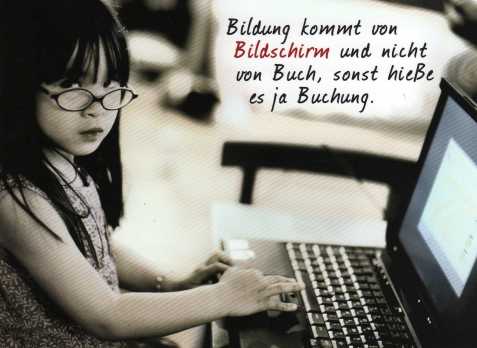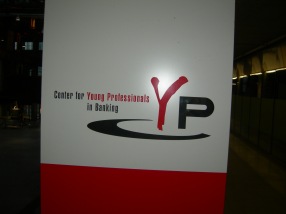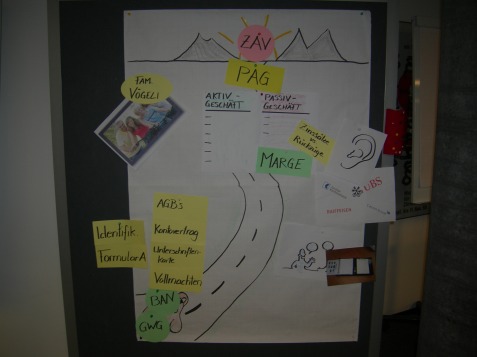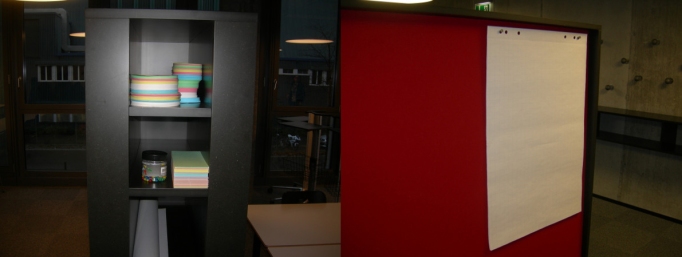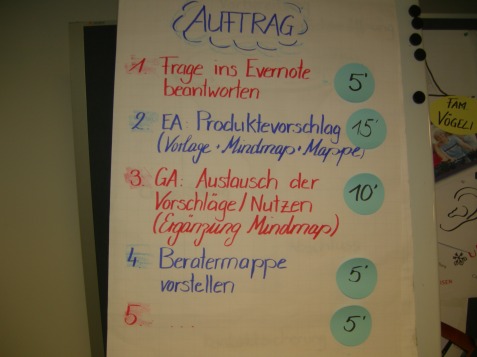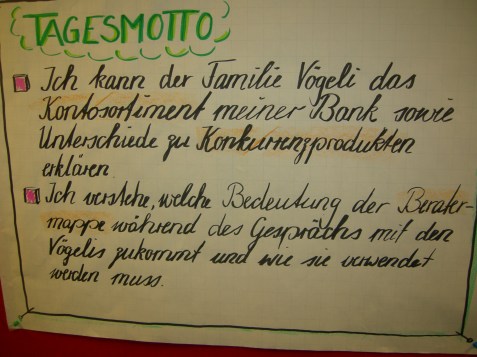Who needs paper? A symbiosis of technology and learning
Image Source : Postcard – Garofalo Design (www.depesche.com)
The BP excursion introduced us to the paperless learning environment of CYP (Center for Young Professionals in Banking) and provided an inspiring glimpse of how future classrooms might look and how technology and learning dovetail to create a so-called Mobile-Learning scenario. There were no cumbersome bags stuffed with books and folders crammed full of photocopies. Our host uttered the word „paper“ as though it were blasphemous. After a while, I could see his point. As a teacher who spends a lot of time photocopying and handing out worksheets, only to discover that those same worksheets end up discarded or destroyed, the notion of doing away with paper is very appealing. It’s a win-win situation as long as students and teachers are able to keep up with technical innovations and, more importantly, if learners are actually using the new media effectively to achieve challenging and rewarding tasks. In the following, I will attempt to evaluate whether this was, in fact, the case at CYP. Read on…..
Question 5.
Which teaching strategies did I witness during my visit to CYP and want to comment on?
I witnessed a plethora of teaching and learning strategies at CYP and there is a large degree of overlap. In this blog, I will focus on individualised learning strategies, developing new understanding from pre-existing knowledge, portioning or „chunking“ of learning tasks, aim-orientation, task-based learning and problem-solving, task planning, creating a positive learning atmosphere and opportunities for self-reflection. Where relevant, I will refer to the BP course literature to underpin any claims and comments.
Strong individualisation of learning arrangements and using new media to access learning resources
„Der Einsatz von modernen Medien ist kritisch zu werten, die neuen Medien werden aber als didaktisches Hilfsmittel geschätzt.“ (Unterrichten an Berufsfachschulen, page 42 – Was Studierenden am BM-Unterricht ins Auge fällt).
CYP exploits the ubiquity of technology for digital natives by providing each student with his/her very own Tablet which enables access to everything there is to know about the course contents via the so-called CYPNet and allows enormous freedom and flexibility. An enhanced eBook is the „all-in-one“ source of material and the „Evernote“ App enables students to document the plenary sessions efficiently and with ease.
During group work and in the subsequent plenary session I saw how they can hook up to an array of online resources, plan ahead, organise themselves and seek guidance. Naturally, they can do this whenever and wherever they choose, no longer dependent on a single location or a rigid timetable. This so-called „connected learning„, is shown in the CYP introductory video, where prospective students can witness how a young man is able to prepare for and do the obligatory pre-test during a break in his football training. In my opinion, this makes the task of learning considerably more attractive. I actually found myself envying the students and wished that my own studies in the 80s had allowed me so much freedom and provided me with so many resources.
The Tablet’s usefulness in plenary classroom work
The implementation of the Tablet clearly nurtures collaborative and autonomous forms of learning if used wisely. Outside the class, students are independent yet always linked with their peers and mentors, and they have the necessary information at their fingertips 24-7. There are downsides to this form of learning inside the class and, to read more about this debate, go to the paperless classroom. As for what I witnessed at CYP, I cannot really vouch for its 100% usefulness in the plenary scenario. Maybe I just didn’t see enough. It would have been good to interview a couple of students, but that was not possible given the schedule and circumstances.
Portioning of complex learning tasks into smaller steps and planning strategies
Image source
„Die Lernprozessorientierung ist ganz entscheidend. Im Unterricht ermöglichte Lernprozesse folgen einem ganz klaren Ablauf: Vorwissenaktivierung, Verstehen, Elaborieren, Organisieren, Konsolidieren“ (Unterrichten an Berufsfachschulen„, pages 67 to 81 – in the chapter about „Unterrichtsgestaltung)
On the day of our visit, I witnessed how the day’s learning schedule was „chunked“ into individual phases. Each phase was divided into manageable „step-by-step“ tasks which were visualised on flipcharts. The tasks complemented each other in increasing order of complexity and culminated in reflection and planning. In an initial plenary session, there was an Advanced Organiser and a breakdown of the forthcoming tasks. This was visualised on a large flipchart and provided a transparent overview of the learning aims and phases.
Strict teaching policy at CYP – no „backtracking“
A strict teaching policy at CYP is that students are expected to prepare in advance and the lesson simply picks up from the point the students are supposed to have reached, with no backtracking. The picture below shows the day’s profile with the learning path literally shown as a road leading off into the distance.
Developing Learning
This pathway shows how students are required to build upon existing knowledge to develop new understanding. During our visit, we saw students developing their understanding of how to address customers‘ financial needs in hypothetical circumstances, implementing skills and knowledge acquired beforehand.
Different learning phases in different learning spaces…
At CYP, it is clear that the different learning environments are tailored to the different phases of learning. Above we see the area where groups can huddle together and exchange ideas or create posters after a plenary session.
The movement from one phase to another is facilitated by the learning environment. Plenary and group work take place in separate areas and the materials (flipcharts, pens, coloured card, etc.) are built into the sturdy dividing walls upon which the students can create flipcharts. Somebody gave this a lot of thought. The pictures below show how convenience is combined with functionality.
Real-world tasks, increasing levels of complexity, good planning and clear information
„Das Material und die Informationen sind klar, verständlich, kohärent und gut strukturiert.“ (Unterrichtsgestaltung, Andreas Helmke, Unterrichten an Berufsfachschulen, page 69)
The plenary planning lead to group work which involved students planning for a „real-world“ related task (a banking consultation with a family). The Tablet-assisted group task was followed by a plenary discussion of what had just happened. Feedback regarding the task completion was given, followed by instructions about the follow-up task. The afternoon session, I discovered, would see the students involved in a „scavenger hunt“ where they would tackle tasks related to the morning session and transfer their results onto flipcharts. Ultimately, they would engage in role-play, where students would simulate a bank situation and take on the roles of customers seeking advice and consultants handling requests, suggesting banking solutions, products, etc.
Each individual phase, from what I could gather, gradually demands more from the learners in terms of personal engagement and allows for task-based consolidation of theoretical knowledge (i.e. from extracting the theoretical knowledge of how to deal with customers (on the CYPNet) to creating products about it (flipcharts and notes), to actually applying this knowledge in a semi-real-life scenario). The controlled circumstances of the classroom provide excellent practice for what they will be expected to achieve in their places of work and „homework“ tasks can be carried out „on the job“.
„Hausaufgaben erfüllen eine wesentliche Brückenfunktion“ (Unterrichten an Berufsfachschulen, page 73)
Aim-orientation – tasks which make sense outside the classroom
„Der Bezug zur Arbeitswelt der Berufslernenden ist wichtig und erleichtert die Vermittlung der Inhalte wesentlich“ (Unterrichten an Berufsfachschulen, page 41 – Was Studierenden am BM-Unterricht ins Auge fällt)
So much of why students fail to achieve good results at school is rooted in their teachers‘ failure to ensure they understand the reasons why they should be learning a particular subject. At CYP, learning outcomes are inextricably linked to real-world challenges. The whole preparation leading towards the role-play scenario exemplifies how students get „hands-on“ practice and leave the classroom equipped with tools which they can use when at work. This enhances motivation because students feel a greater sense of confidence in their own practical abilities. There is an instant trade off between effort and reward.
Task-based group organisation and mentors
The group work I saw was organized so that students could a) work individually with their own Tablets and b) benefit from each other’s experience of doing so by having opportunities to show each other their work and talk about it with peers and the three mentors who were at hand. The group work aims were clearly defined on a flipchart (see below). This preparation increases the effectiveness of any subsequent role-play tasks. The aims are „I can“ formulations and act as signposts along the learning pathway.
Creating a positive atmosphere
1. Making success visible and providing ways for students to reflect on their own performance
Apprentices are able to monitor their progress via the enhanced eBook where there is a „self-check bar“ which tells them how much they have achieved. Also, CYP provides feedback to the banks about how well the apprentices are performing in the course. This transparency allows both apprentice and employer to understand achievements and potential deficits. Additional coaching is at hand should the need arise. This is surely a source of motivation and provides a safety net for learners who might be experiencing difficulties. There was no hint that students feel in any way threatened by this and, I am sure, the banks welcome these insights into their future employees‘ capabilities. Students‘ metacognitive skills are developed when they are given feedback in this way. They are given the chance to assess, regulate and hone their own learning skills. This, in turn, is intended to enhance the students‘ feeling of self-efficacy. Our host, Thomas Kölliker mentioned that, at CYP, they try to focus on achievements and turn deficits into positive learning opportunities.
Creating a positive atmosphere
2. Ensuring that learning is not a chore with no time for distractions….
It was obvious from what I saw that every effort has been made to ensure that learning challenges are achievable and require students to become active enquirers. Interestingly, students are not tempted to check their Facebook accounts, watch YouTube videos or surf the Internet in search of funny images. They simply haven’t got time and the learning is structured in such a way that they have no need to distract themselves. We stood at the back of the plenary session and had full view of the students‘ activities on their Tablets and everyone was on-task. I have had other experiences in classrooms where students have taken advantage of being allowed to go online.
And finally, a critical view….
CYP can be said to be at the cutting edge of innovation in terms of paperless learning. The debate goes on and the jury is out as to whether this is a viable or desirable vision of the future. The enhanced eBook isn’t available for every subject, substantial funding is a pre-requisite and, not surprisingly, many publishers haven’t yet caught up. Needless to say, they will, and we can envisage a future where tutorials will only be held online. So, are virtual classrooms the death knell of traditional schools with real classrooms and real teachers? I think not.
In my humble opinion, this is a utopian image. With an increasing demand for people to become highly adaptive divergent thinkers, stipulating that all learning take place online is as restrictive as it is naïve. Many roads lead to Rome. To consider one form of learning at the expense of another is to be caught in an either-or fallacy. The essence is the art of striking a balance between exploiting online learning and implementing solid teaching strategies which enhance the former.
Andreas Helmke points out the importance of the teacher:
„Schülerinnen und Schuler lernen besser wenn eine Lehrperson als motivierend, anregend, stimulierend erlebt wird und ihr das Fach erkennbar Spass macht“ (Unterrichten an Berufsfachschulen, page 69, Didaktische Expertise)
At CYP, I do not believe they underestimate this importance, nor do they believe that their form of Tablet-based learning is the panacea which will revolutionize their students‘ chances of success.
Whilst I remain critical of the effectiveness of how Tablets are used in classes at CYP, I also witnessed teachers as role models and saw how they implemented a number of different teaching strategies to enable their students to reach their learning aims. Let us not fool ourselves into thinking that the Tablet is anything more than simply a tool, a highly elaborate version of the chalk and slate….
